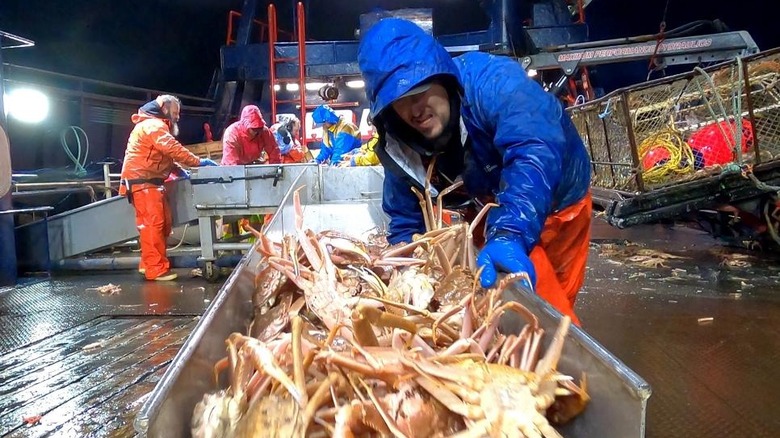How Do The Deadliest Catch Captains Target The Right Type Of Crab?
Discovery's documentary series "Deadliest Catch" has documented the perils faced by Alaskan crab fishermen for 19 seasons and more than 300 episodes, billing the profession as the world's most dangerous.
Seasonal quotas and other safety measures have lowered fatalities among fishermen in recent years. Despite this, extreme weather, rough seas, and heavy equipment still pose significant dangers to the crews that operate the many boats in and around the icy waters of the Bering Sea. Crab fishing is a complex science, particularly when it comes to targeting particular varieties for a catch.
Fishermen use many tactics to land a certain variety of crab: using specific baits, fishing in areas with a certain seafloor composition, and fishing when environmental conditions match the habitat of a particular species.
In a thread on the r/DeadliestCatch subreddit, u/slaidcravin pointed out how "Deadliest Catch" fishermen fish different areas for different species. "Each type of crab prefers a different kind of bottom and bait .... tanner like mud, opies like sand, and king crab like shale and cobble/rocky gullies," they wrote.
Another commenter, u/playmeortrademe, mentioned a wider set of environmental factors that come into play for fishermen looking to zero in on a certain variety of crab. "Different types of crab prefer different environments," they wrote. "King crab live relatively shallow and will be found [in] rockier areas usually whereas snow crab are a lot deeper and like sandy/muddy bottoms. Water temps can play a big [role] as well."
Crabs favor fish local to the waters they're in
In that same thread, u/Aggressive-Set3049 compared crab fishing to other types of commercial fishing, pointing out that a great deal of research goes into the selection of fishing spots. They also noted that a crew's experience also plays an important role in the success of an expedition. "[It's the] Same as fishing for any specific fish in one big ocean," they wrote. "Depends on bait, time of year, where they live and what they eat. It's what makes a great fisherman a great fisherman. They know their migratory patterns, and they keep logs of past fishing trips to give them a general reference for future fishing."
For recreational crabbers, Crabbing Hub suggests that using a variety of baits can lead to success, including fish, chicken, turkey, eels, and even pig's feet. The site recommends augmenting any bait with oily fish like tuna or sardines, even suggesting that a can of tuna with a small hole in it can be an effective lure.
Another recommendation is to use bait that is local to the waters being fished. "The best bait you could use is freshly caught fish from the same body of water where you are crabbing. Chicken, squid, turkey, or any type of oily meats will also get the job done."

